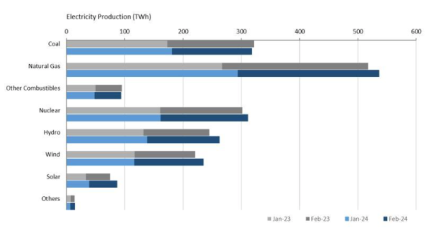
The International Energy Agency’s latest monthly statistics report shows that in February 2024, the total net electricity production of OECD membership reached 869.1 TWh, marking a 2.3% increase compared to the same period last year.
However electricity generation from fossil fuels amounted to 397.3 TWh, a decline of 5.2% (equivalent to 21.8 TWh) compared to February 2023. This reduction was largely driven by lower electricity output from coal, which experienced an 8.3% year-on-year fall, followed by gas with a decrease of 3.3% year-on-year. The reduction in coal-fired generation was evident across all OECD regions, with OECD Europe experiencing the most significant decline at 20.3% year-on-year, followed by OECD Asia Oceania at 4.0% year-on-year and the OECD Americas at 3.3% year-on-year. The drop in natural gas electricity production was apparent in OECD Europe (-26.4% y-o-y) and OECD Asia Oceania (-3.5% y-o-y), whereas the OECD Americas witnessed a 5.9% y-o-y increase. Overall, fossil fuels accounted for 45.7% of the electricity mix.
Renewables increase significantly
Electricity production from renewable sources increased by 11.4% y-o-y at 320.0 TWh in February 2024. This growth was primarily driven by increased generation from wind power, with OECD Europe leading the trend with a notable 29.8% year-on-year increase, equivalent to 15.1 TWh. Hydropower generation also experienced a significant rise of 9.8% year-on-year, driven by increased output in OECD Europe (+34.4% y-o-y) and OECD Asia Oceania (+21.9% y-o-y), although it declined in the OECD Americas by 7.9% year-on-year. Solar power generation continued its upward trend, with significant increases observed in the OECD Americas (+30.4% y-o-y) and in OECD Europe (+9.9% y-o-y). Overall, renewables sources contributed 36.8% to total production in February 2024, marking an increase of 3 percentage points compared to the same month the previous year.
Nuclear electricity production reached 149.2 TWh in February 2024, reflecting a 6.0% increase compared to the same month last year. This growth was attributable to increased nuclear output across all OECD regions, the OECD Americas leading with a 5.4% year-on-year increase, followed by OECD Asia Oceania (+13.2% y-o-y) and OECD Europe (+4.2% y-o-y). Overall, nuclear power contributed 17.2% to the electricity mix.
Dry conditions in Canada
In Canada, total net electricity production amounted to 52.9 TWh in February 2024, falling by 5.1% in the year. This trend was driven by a decrease in electricity generated from hydro which declined by 12.5% y-o-y and represented 58.3% of the electricity mix. This was caused by prolonged dry conditions across much of the country, witnessed before during 2023. Consequently, Canada’s trade balance was affected, registering lower export volumes and increased imports to compensate for the reduced electricity output.




